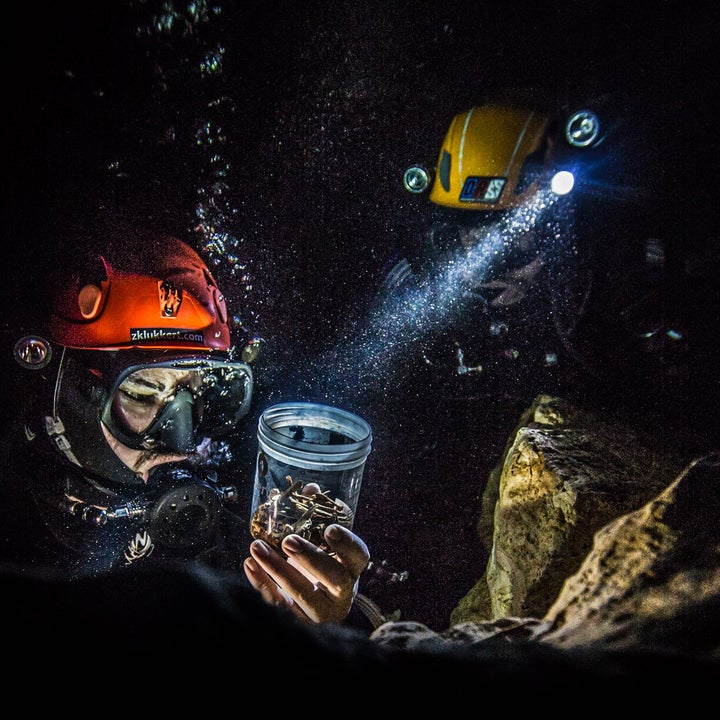Visibility was so poor that Zachary Klukkert could barely see his hand in front of his face as he carefully swished the muck away from the skull of an extinct giant ruffed lemur. He was 40 feet underwater, diving deep below the surface of Aven Cave, an . His headlamp cast a narrow beam, and after stirring up silt on the cave floor, the water had become so turbid he barely noticed the lemur's otherwise intact teeth were not the pearly white hue he had expected.
In the cave, Klukkert,��a��primatologist��finishing his PhD at City University of New York, was surrounded by crocodile and lemur skeletons and��couldn’t help but think about��how well preserved this scene had remained for hundreds, if not thousands, of years.
“It’s completely a mystery. You have no idea what you’re getting into or what’s around the corner.”
In the 21st century, . We’ve summited the highest mountains and plumbed the deepest depths of the oceans, yet underwater caves have retained centuries’ worth of secrets unknown to modern humans. The quality and quantity of skeletal remains found in Aven Cave—as well as remains recently discovered in other underwater caves in Madagascar, Mexico, and Hispaniola—have��far surpassed that of anything previously found on land.��This has��been a boon for scientists studying primate evolution and the ancient world. Our early forays into these previously untouched environments in the past two decades��has signaled a .
“When Edmund Hilary made the first ascent of Everest, he knew what was waiting for him at the top. There was no mystery,” says Phillip Lehman, diver and founder of the , which helps organize research of underwater caves. Lehman has explored and mapped dozens of these previously uncharted caverns including , perhaps the largest in the world. “In cave diving it’s the opposite. .”
In 2007, after three years of surveying nearly 100,000 feet of , Venezuelan diver Alberto Nava and his team found and entered , a cave 200 feet in diameter and more than 100 feet deep. There they , approximately 12,000 year old, which are possibly the oldest of any human ever found in North America. They named her Naia. Her discovery could help shed light on when and where humans came to the Americas and how they evolved as a species. Since then, Nava and his team have continued to catalogue the cave’s contents and have found skeletons of extinct giant ground sloths, saber-toothed cats, and gomphotheres, an extinct species related to elephants.
Propelling these types of discoveries are advances in diving technology and techniques over the past two decades that have given us access to places previously unreachable. ; stronger lighting has improved visibility; and subaquatic scooters and computers have enhanced mobility. We’re now able to study bacteria in the “blue holes” of the Bahamas, whose conditions mirror those of the oxygen-free environments where life first took hold��on the planet 4 billion years ago. By studying these organisms, scientists hope to learn more about the possibilities of life on other planets. Elsewhere, researchers are looking to these caves��to shed light on past climate change events to better predict future climatic shifts.
Underwater caves also give adventurers opportunities to push the limits of exploration. in the Czech Republic for 17 years before confirming, in 2016, that (at 1,325 feet deep). This expedition was an all-out assault that required a large team, GIS��mapping capabilities, high powered lights, and a to make the final descent.
Though we don’t know how many virgin caves are out there, we continue to find new ones and push further into known ones as well. For example, Lehman and his team are mapping Malaza Manga in hopes of confirming its status as the world’s largest submerged cave. Canadian cave diver Jill Heinerth is through icebergs and submerged ice caves at both poles. Excursions��are underway around the world.
“What we’re finding in these difficult-to-reach places are paleontological finds, geological discoveries, new species, so it’s pretty important in terms of scientific research and exploration,” says Rebecca Martin, senior director of , which sponsored both Starnawski and Nava’s expeditions. “There is a whole unknown realm within the planet and we’re just breaking ground.”


